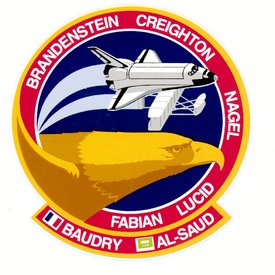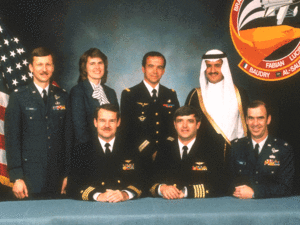STS-51-G
|
|
| Mission Insignia | |
|---|---|

| |
| Mission Statistics | |
| Mission: | STS-51-G |
| Shuttle: | Discovery |
| Launch Pad: | 39-A |
| Launch: | Jun. 17,1985,7:33:00 a.m, EDT |
| Landing: | June 24, 1985, 6:11:52 a.m. PDT, Runway 23, Edwards Air Force Base, Calif. |
| Duration: | Seven days, one hour, 38 minutes, 52 seconds. |
| Orbit altitude: | 209 nautical miles (387 km) |
| Orbit inclination: | 28.45 degrees |
| Distance traveled: | 2,916,127 miles (4,693,051 km) |
| Crew photo | |
 Back L-R: Nagel, Lucid, Baudry, Al-Saud Front L-R: Creighton, Brandenstein, Fabian | |
STS 51-G was the eighteenth flight of a Space Shuttle and the fifth flight of Discovery.
| Contents |
Crew
- Daniel C. Brandenstein (flew on STS-8, STS-51-G, STS-32 & STS-49), Commander
- John O. Creighton (flew on STS-51-G, STS-36 & STS-48), Pilot
- Shannon W. Lucid (flew on STS-51-G, STS-34, STS-43, STS-58 & Mir NASA-1), Mission Specialist 1
- John M. Fabian (flew on STS-7 & STS-51-G), Mission Specialist 2
- Steven R. Nagel (flew on STS-51-G, STS-61-A, STS-37 & STS-55), Mission Specialist 3
- Patrick Baudry (flew on STS-51-G), Payload Specialist 1 - France
- Sultan Salman Al-Saud (flew on STS-51-G), Payload Specialist 2 - Saudi Arabia
Mission parameters
- Mass:
- Orbiter Liftoff: 116,310 kg
- Orbiter Landing: 92,607 kg
- Payload: 20,174 kg
- Perigee: 358 km
- Apogee: 369 km
- Inclination: 28.5°
- Period: 91.8 min
Mission highlights
The Orbiter Discovery lifted off from Pad A, Launch Complex 39, KSC, at 7:33 a.m. EDT on June 17, 1985. The largest items of cargo were three communications satellites. Also flown were the deployable/retrievable Spartan 1, six Getaway Special canisters, a High Precision Tracking Experiment (HPTE) for the Strategic Defense Initiative ("Star Wars"), a materials processing furnace, and French biomedical experiments. All three communications satellites were successfully deployed and turned over to their owner-operators. Their PAM-D perigee booster motors fired and all three reached geosynchronous orbit, where they entered checkout operations. Spartan 1 was deployed and recovered. All the experiments were successfully accomplished. Discovery landed at Edwards AFB at 9:12 a.m. EDT on June 24, 1985, after a mission duration of 7 days, one hour and 39 minutes.
The crew members were Daniel C. Brandenstein, commander; John O. Creighton, pilot; Shannon W. Lucid, Steven R. Nagel, and John M. Fabian, mission specialists; and Patrick Baudry, France, and Prince Sultan Salman Al-Saud, Saudi Arabia, payload specialists. deployed were the Arabsat 1-B (Arab Satellite Communications Organization); Morelos 1 (Mexico); and Telstar 3-D (AT&T). All three utilized PAM-D booster stages to achieve geosynchronous transfer orbits after deployment from the Discovery. The latter two spacecraft are variants of the Hughes-built HS-376 series of spin- stabilized satellites. Both use the Morton Thiokol Star 48 motor to circularize the orbit and align it with the equator at apogee. Morelos 1 provides 12 channels operating in the C-band and 6 channels operating in the Ku band. It can provide educational and commercial television programs, telephone and facsimile services, and data and business transmission services to even the most remote parts of Mexico. Telstar 3-D operates in the C-band only, and has 24 working channels. Using single sideband technology, a Telstar can relay up to 86,400 two-way telephone calls. Both spacecraft are about 22 ft (6.7 m) high and 7 ft (2.1 m) wide when deployed, and have a mass of around 1,450 lb (658 kg) when operational.
Arabsat 1 satellites are built by an international team led by Aerospatiale of France. It is a three-axis stabilized spacecraft with two deployable solar array wings, making it almost 68 ft (20.7 m) long and over 18 ft (5.5 m) wide when deployed in orbit. It weighs about 2,800 lb (1,270 kg) in its initial orbit, but some 1,490 lb (676 kg) of this is propellant. It has an onboard low-thrust motor that utilizes hydrazine and nitrogen tetroxide, and transfers from an initial elliptical to geosynchronous orbit by firing this motor. The remaining propellant is then used for station-keeping or moving over the life of the satellite.
Spartan 1 measured 126 by 42 by 48 inches (3.2 by 1.1 by 1.2 m), and weighed 2,223 lb (1,008 kg). The Spartan is a carrier, designed to be deployed from the orbiter and fly free in space before being retrieved. Spartan 1 included 300 lb (136 kg) of experiments in the field of astronomy. It was deployed and operated successfully, independent of the orbiter, before being retrieved.
The materials furnace, French biomedical experiments, and six Getaway Special experiments were all successfully performed, although the GO34 Getaway Special shut down prematurely. The Strategic Defense Initiative failed during its first try on orbit 37 because the orbiter was not at the correct attitude. It was successfully completed on orbit 64.
Three communications satellites, all attached to Payload Assist Module-D (PAM-D) motors, were deployed: MORE LOS-A, for Mexico; ARABSAT-A, for Arab Satellite Communications Organization; and TELSTAR-3D, for AT&T. Also flown: deployable/retrievable Shuttle Pointed Autonomous Research Tool for Astronomy (SPARTAN-1); six Get Away Special canisters; Strategic Defense Initiative experiment called the High Precision Tracking Experiment (HPTE); a materials processing furnace called Automated Directional Solidification Furnace (ADSF); and two French biomedical experiments.
Related articles
- Space science
- Space shuttle
- List of space shuttle missions
- List of human spaceflights chronologically
External links
- NASA mission summary (http://science.ksc.nasa.gov/shuttle/missions/51-g/mission-51-g.html)
| Previous Mission: STS-51-B |
Space Shuttle program | Next Mission: STS-51-F |
